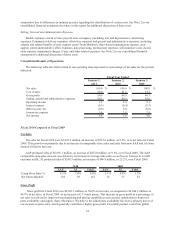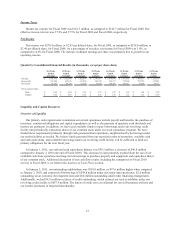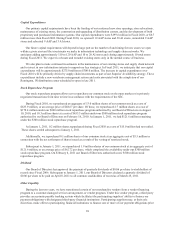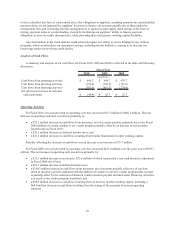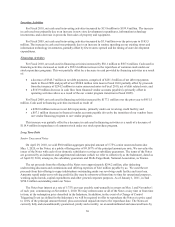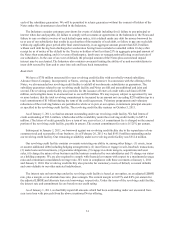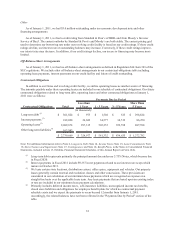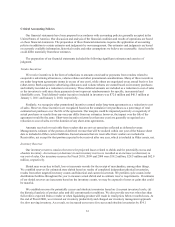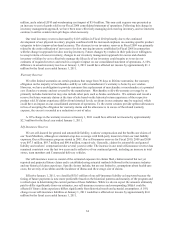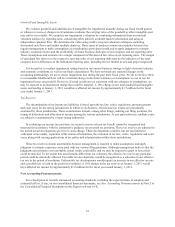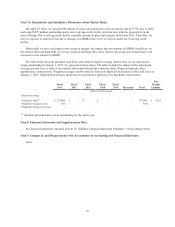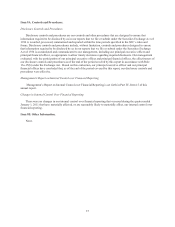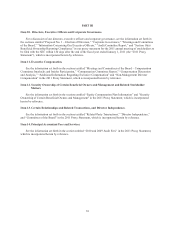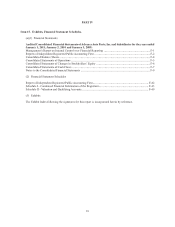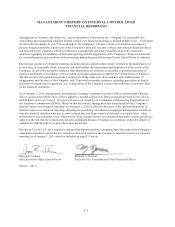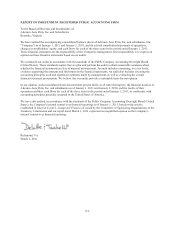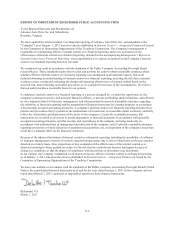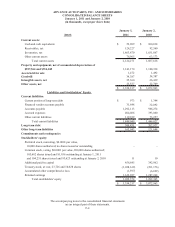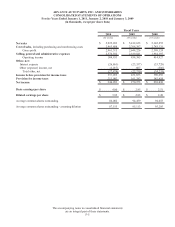Advance Auto Parts 2011 Annual Report Download - page 49
Download and view the complete annual report
Please find page 49 of the 2011 Advance Auto Parts annual report below. You can navigate through the pages in the report by either clicking on the pages listed below, or by using the keyword search tool below to find specific information within the annual report.34
million, and a related LIFO and warehousing cost impact of $3.4 million. This non-cash expense was presented as
an increase to cost of goods sold in our Fiscal 2008 consolidated statement of operations. Following this change in
inventory management approach, we have been more effectively managing slow moving inventory, and we intend to
continue to utilize vendor return privileges when necessary.
Our total inventory reserves decreased by $10.3 million in Fiscal 2010 primarily due to the continued
development of our physical inventory program combined with the increased emphasis on counting specific product
categories to drive improved on-hand accuracy. The decrease in our inventory reserves in Fiscal 2009 was primarily
related to the entire utilization of our reserve for slow moving inventory established in Fiscal 2008 in connection
with the change in approach for slow moving inventory. Future changes by vendors in their policies or willingness
to accept returns of excess inventory, changes in our inventory management approach for excess and obsolete
inventory or failure by us to effectively manage the lifecycle of our inventory could require us to revise our
estimates of required reserves and result in a negative impact on our consolidated statement of operations. A 10%
difference in actual inventory reserves at January 1, 2011 would have affected net income by approximately $1.1
million for the fiscal year ended January 1, 2011.
Warranty Reserves
We offer limited warranties on certain products that range from 30 days to lifetime warranties; the warranty
obligation on the majority of merchandise sold by us with a manufacturer’s warranty is borne by our vendors.
However, we have an obligation to provide customers free replacement of merchandise or merchandise at a prorated
cost if under a warranty and not covered by the manufacturer. Merchandise sold with warranty coverage by us
primarily includes batteries but may also include other parts such as brakes and shocks. We estimate and record a
reserve for future warranty claims at the time of sale based on the historical return experience of the respective
product sold. If claims experience differs from historical levels, revisions in our estimates may be required, which
could have an impact on our consolidated statement of operations. To the extent vendors provide upfront allowances
in lieu of accepting the obligation for warranty claims and the allowance is in excess of the related warranty
expense, the excess is recorded as a reduction to cost of sales.
A 10% change in the warranty reserves at January 1, 2011 would have affected net income by approximately
$2.3 million for the fiscal year ended January 1, 2011.
Self-Insurance Reserves
We are self-insured for general and automobile liability, workers' compensation and the health care claims of
our Team Members, although we maintain stop-loss coverage with third-party insurers to limit our total liability
exposure. Our self-insurance program started in 2001. Our self-insurance reserves for Fiscal 2010, 2009 and 2008
were $97.3 million, $93.7 million and $90.6 million, respectively. Generally, claims for automobile and general
liability and workers’ compensation take several years to settle. The increase in our total self-insurance reserves has
remained consistent over the last two years and is reflective of our continued growth, including an increase in total
stores, team members and Commercial delivery vehicles.
Our self-insurance reserves consist of the estimated exposure for claims filed, claims incurred but not yet
reported and projected future claims and is established using actuarial methods followed in the insurance industry
and our historical claims experience. Specific factors include, but are not limited to, assumptions about health care
costs, the severity of accidents and the incidence of illness and the average size of claims.
Effective January 1, 2011, we classified $50.3 million of our self-insurance liability as long-term because the
timing of future payments is now more predictable based on the historical patterns and maturity of the program and
is relied upon in determining the current portion of these liabilities. While we do not expect the amounts ultimately
paid to differ significantly from our estimates, our self-insurance reserves and corresponding SG&A could be
affected if future claim experience differs significantly from historical trends and actuarial assumptions. A 10%
change in our self-insurance liabilities at January 1, 2011 would have affected net income by approximately $6.0
million for the fiscal year ended January 1, 2011.


